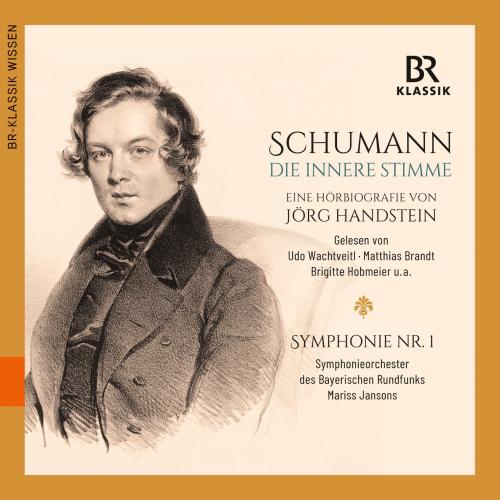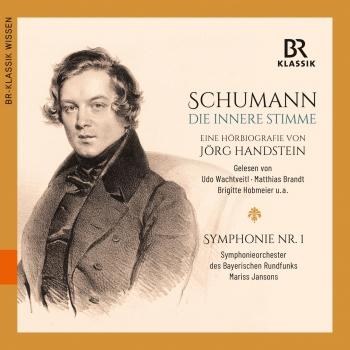
R. Schumann: Die innere Stimme Udo Wachtveitl, Matthias Brandt, Brigitte Hobmeier, Symphonieorchester des Bayerischen Rundfunks & Mariss Jansons
Album Info
Album Veröffentlichung:
2019
HRA-Veröffentlichung:
04.01.2019
Das Album enthält Albumcover Booklet (PDF)
- 1 Kapitel 1: Berühmt unter allen Umständen (1810-1828) 22:48
- 2 Kapitel 2: Poesie und Prosa (1828-1830) 23:42
- 3 Kapitel 3: Maskeraden (1830-1834) 23:14
- 4 Kapitel 4: Erster Kuss im November (1834-1837) 24:05
- 5 Kapitel 5: Wieck gegen Wieck (1838-1840) 23:53
- 6 Kapitel 6: Trautes Heim (1840-1843) 23:41
- 7 Kapitel 7: Völkerfrühling (1844-1849) 25:15
- 8 Kapitel 8: Rheinische Symphonie (1849-1851) 24:00
- 9 Kapitel 9: Aufregungen (1851-1853) 24:02
- 10 Kapitel 10: Engel und Dämonen (1853-1856) 26:52
- Robert Schumann (1810 - 1856): Symphony No. 1 in B-Flat Major, Op. 38 "Spring":
- 11 Symphony No. 1 in B-Flat Major, Op. 38 "Spring": I. Andante un poco maestoso - Allegro molto vivace (Live) 11:17
- 12 Symphony No. 1 in B-Flat Major, Op. 38 "Spring": II. Larghetto (Live) 07:03
- 13 Symphony No. 1 in B-Flat Major, Op. 38 "Spring": III. Scherzo. Molto vivace (Live) 05:38
- 14 Symphony No. 1 in B-Flat Major, Op. 38 "Spring": IV. Allegro animato e grazioso (Live) 08:39
Info zu R. Schumann: Die innere Stimme
Dass Schumann zu den wichtigsten Stimmen der musikalischen Romantik gehört, ist unbestritten. Doch manche Fragen werden noch heiß diskutiert: Wie war sein Verhältnis zu seiner Ehefrau Clara, der größten Pianistin des 19. Jahrhunderts? Was brachte ihn in die Irrenanstalt? Woran starb er? Reißerisch präsentierte „Enthüllungen“ stellen oft Schumanns übriges Leben in den Hintergrund. Dabei hat er eine innerlich ungemein reiche Biografie in einer bewegten Epoche. Auf der Basis des gesicherten Wissens erzählt diese Hörbiografie die ganze Geschichte.
In Deutschland gärte es politisch und künstlerisch, und Schumann war auf der Suche nach einer neuartigen Musik, die dieser erregten Zeit Ausdruck gibt. In seiner Humoreske op. 20 steht eine „Innere Stimme“, die nur imaginär gesungen wird. „Unbekannte Gesänge, die ich nie gehört, durchströmten mein Inneres – Gesänge, die mich wie Geisterstimmen umtönten.“ So heißt es in E.T.A. Hoffmanns Kreisleriana, die Schumann zu seinem gleichnamigen Klavierzyklus inspirierten. Und im Februar 1854 hörte er selbst derartige Stimmen – bekanntlich der Anfang vom Ende. Ein Zufall? Eine vielstimmige Hörbiografie kann solchen untergründigen Zusammenhängen am besten nachgehen, und so liefert die „Innere Stimme“ auch deren Titel und Leitgedanken. Sie steht für Schumanns enorme Kreativität ebenso wie für seine labile, gefährdete Psyche und seine Feinfühligkeit für Weltveränderungen.
Die zehnteilige Hörbiografie gibt auch Schumanns wilder Jugendzeit breiten Raum und natürlich dem aufwühlenden Kampf um Clara, dem wohl größten „Liebesroman“ der Musikgeschichte. Allerdings wird nichts hinzugedichtet: Alles beruht auf den originalen Quellen, die dramatisch genug sind, lebensnah und berührend. Und wie in einer normalen Biografie kaum möglich, spielt die Musik eine Hauptrolle: Rund 150 Ausschnitte aus Werken aller Gattungen beleuchten Schumanns Schaffensweg, darunter auch selten zu hörende Frühwerke und Raritäten. Interpreten wie John Eliot Gardiner, Nikolaus Harnoncourt, Eric Le Sage und Christian Gerhaher bürgen für höchste Qualität. Eine komplette, erst im März 2018 entstandene Live-Aufnahme der „Frühlingssymphonie“ mit dem Symphonieorchester des Bayerischen Rundfunks unter der Leitung von Mariss Jansons ergänzt die Hörbiografie. Auch herausragende Schauspieler wie Udo Wachtveitl (Erzähler), Matthias Brandt (Robert Schumann) und Brigitte Hobmeier (Clara) sorgen für besonderen Hörgenuss.
Udo Wachtveitl (Erzähler)
Matthias Brandt (Robert Schumann)
Brigitte Hobmeier (Clara Schumann)
Michael Tregor (Friedrich Wieck)
Thomas Albus, Christian Baumann, Folkert Dücker u. a. (Zitate)
Jörg Handstein (Autor)
Bernhard Neuhoff (Redaktion und Regie)
Symphonieorchester des Bayerischen Rundfunks
Mariss Jansons, Dirigent
Mariss Jansons
Born in 1943 in the Latvian capital of Riga, Mariss Jansons grew up in the Soviet Union as the son of conductor Arvid Jansons, studying violin, viola and piano and completing his musical education in conducting with high honours at the Leningrad Conservatory. Further studies followed with Hans Swarovsky in Vienna and Herbert von Karajan in Salzburg. In 1971 he won the conducting competition sponsored by the Karajan Foundation in Berlin. His work was also significantly influenced by the legendary Russian conductor Yevgeny Mravinsky, who engaged Mariss Jansons as his assistant at the Leningrad Philharmonic in 1972. Over the succeeding years Mariss Jansons remained loyal to this orchestra, today renamed the St. Petersburg Philharmonic, as a regular conductor until 1999, conducting the orchestra during that period on tours throughout the world. From 1971 to 2000 he was also professor of conducting at the St. Petersburg Conservatoire.
In 1979 he was appointed Music Director of the Oslo Philharmonic Orchestra, with which ensemble he performed, recorded and toured extensively. It was in 1996, whilst in Oslo, that Jansons had a serious heart attack whilst on the podium. He was subsequently fitted with a defibrillator. (Earlier Jansons's father had died while conducting the Halle Orchestra in Manchester). Jansons remained with the Oslo orchestra until 2000. In 1992, he became principal guest conductor of the London Philharmonic Orchestra and in March, 1997, he was appointed music director of the Pittsburgh Symphony Orchestra.
Since 2003 Jansons has been Chief Conductor of the Bavarian Radio Symphony Orchestra and Chorus. After two exceptionally successful seasons his contract was extended in June of 2005 for three additional years until 2009. Mariss Jansons follows Eugen Jochum, Rafael Kubelík, Sir Colin Davis and Lorin Maazel as the fifth Chief Conductor of these two renowned Bavarian Broadcasting ensembles. In 2004 Jansons assumed the position of Chief Conductor of the Royal Concertgebouw Orchestra in Amsterdam.
Mariss Jansons places special emphasis on his work with young musicians. He has conducted the Gustav Mahler Youth Orchestra on a European tour and worked with the Attersee Institute Orchestra, with which he appeared at the Salzburg Festival. In Munich he gives regular concerts with various Bavarian Youth Orchestras and the Academy of the Symphonieorchester des Bayerischen Rundfunks. He is also Artistic Director of the Masterprize Composing Competition.
Mariss Jansons’s discography includes many recordings for EMI, some of which have received prestigious international prizes. The recording of Shostakovich’s Symphony No.7 with the Leningrad Philharmonic won the 1989 Edison Prize and his recordings of Berlioz’s “Symphonie fantastique” and Dvorák’s Fifth Symphony were awarded, respectively, the Dutch Luister Prize and the Penguin Award. In 2005 Mariss Jansons concluded recording his cycle of all the Shostakovich Symphonies, an EMI project in which a number of major orchestras participated.
On January 1, 2006, Mariss Jansons was, for the first time, conductor at the annual New Year’s Concert of the Vienna Philharmonic, which was telecast by 60 different stations on every continent and seen by more than fifty million viewers.
Booklet für R. Schumann: Die innere Stimme










